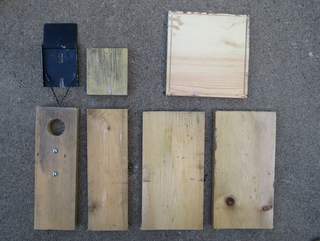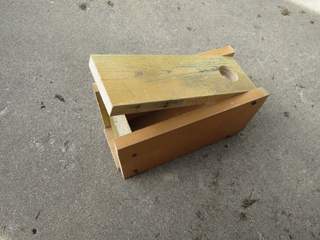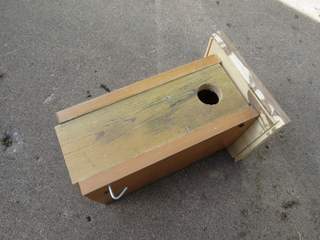I first created this site back in 1998 to document the wild plants that I encountered. But it has grown into a clearinghouse of information on landscaping, backyard birds, butterfly gardening, plant identification and making paper from plant fiber. After leaving Kansas, I thought of deleting the site. But realize it has a wealth of information that people rely upon.
Hosting the site is involved. I’d like to thank those who have donated to help defray the web site hosting fees. If you would like to contribute, please click the Donate button. Thank you.
Nest Box Design
About Nest Boxes
 Front opening nest box
Front opening nest boxA nest boxes is a man-made structure in which birds nest.
Most people use the term "birdhouse" to describe a man-made structure in which birds nest. A more appropriate term is "nest box" as the box serves birds as a site to nest. A nest box is generally enclosed on all sides as well as the top and the bottom. Entrance to the nest box is usually a hole.
The kinds of birds that use nest boxes are known as cavity nesters. Their natural nest is normally in an existing cavity found in a tree. An example of a natural cavity would be an old woodpecker nest or a rotted out cavity. Dead trees generally have more cavities in them as the wood becomes soft with time. Unfortunately dead trees are not commonly found in our landscapes, but nest boxes can be used to replace or supplement natural cavities.
Backyard cavity nesting birds include our native bluebirds, chickadees, titmice, woodpeckers, flickers, great-crested flycatchers, and screech owls.
Native cavity nesters found in more rural areas also include tree swallows, wood ducks, kestrels, and barn owls.
The introduced house sparrow and European starling also nest in cavities and negatively compete with our native cavity nesters. Do not allow them to nest in birdhouses as they compete negatively with our native birds.
Learn more about Cavity Nesting Birds.
Nest Box Design
Traits of a well constructed nest box
- The design of the nest box is crucial for monitoring nesting species. The box must be easy to open. Use a front opening nest box for all species except woodpecker. Woodpecker nest boxes should be top opening.
- The design should allow trapping house sparrows and starlings which compete with our native birds. Both the front and top opening boxes work well with nest box traps.
- A front opening box has two screws near the top of the front that act as a hinge when the box is opened. The screw at the bottom front secures it to the nest box.
- A top opening box is necessary for woodpeckers as the nest boxes must be filled with aspen shavings and are much deeper than other nest boxes. A front opening nest box would cause the aspen shavings along with the nest to fall out. I use two screws mounted diagonally to fasten the roof to the box.
- A nest box with a flat roof is easier to construct than a nest box witha slanted roof. The flat roof should overhang all sides of the box and drip lines should be cut on all sides of the bottom side of the roof. This will prevent water from seeping into the nest box.
- The floor should be recessed into the sides. I do not include drain holes as the key to a dry nest is a roof that doesn't leak.
- The board with the hole in it should be roughened on the inside to allow young birds to climb to the hole for feeding and fledging. Scoring the board will create a roughened surface that birds can cling to. I use a flat head screwdriver to scratch the surface by making horizontal lines spaced about a quarter inch apart.
- The outside front board should be roughened to allow adult birds to cling to the house when inspecting it and feeding the young.
Comparison of Front & Top Opening Nest Boxes
| Characteristic | Front Opening Nest Box | Top Opening Nest Box |
|---|---|---|
| Nest Box Trap | Nest Box Trap is easily mounted for catching house sparrows and starlings | Nest Box Trap is easily mounted for catching house sparrows and starlings |
| Cleaning | Box can be opened and old nest can be swept out. | Box must be tipped upsidedown to remove all debris |
| Monitoring | Front is opened to see inside nest box. May be difficult to see contents of the nest, especially when the nest fills up the nest box. | Top is opened to see inside nest box. A step ladder may be necessary to look into the box. It offers the best view of the nest and its contents. |
| Construction | Two screws act as a hinge and one screw keeps the door fastened. | Two screws keep the roof fastened. To check the nest box, remove one screw and pivot the roof on the other screw. |
| Photography | Difficult to photograph nest and contents. | Easy to photograph nest and contents. |
Nest Box Dimensions
I've researched recommended sizes for nest boxes and different sources give different information. I find that most literature recommends boxes that are larger than the species prefer. Birds like to feel secure in their nest box. Roomy nest boxes are not necessarily preferred by birds.
My dimensions are also based on finished lumber sizes. Using finished lumber sizes allows minimal cutting. The least expensive wood to use for building nest boxes is white pine. It is readily available in 1" thickness and even sized widths. Lumber sizes are the dimensions of the lumber before it is finished (planed smooth). For example, a 1 x 4 after planing is ¾" thick and 3½" wide.
Finished Lumber Sizes
| Board Dimension | Actual Dimension |
|---|---|
| 1" x 4" | ¾" x 3½" |
| 1" x 6" | ¾" x 5½" |
| 1" x 8" | ¾" x 7¼" |
| 1" x 10" | ¾" x 9¼" |
Nest Box Sizes
For smaller birds, my favorite size nest box has an interior floor dimension of 3½ X 4 inches and an interior depth of 9 inches. This size will accommodate the largest number of species. The most useful birdhouse hole size for smaller birds is 1½ inches in diameter. This size will allow wrens, chickadees, titmice, bluebirds, and swallows to enter, but will exclude the larger starling. The 1½ inch hole will unfortunately allow house sparrows to enter the nest box. For chickadees and house wrens I recommend a 1 1/8" hole to prevent house sparrows from being able to enter.
Starlings and house sparrows must not be allowed to nest in nest boxes.
| Inside Board Dimension | Outside Board Dimension | Inside Floor Dimension | Birds |
|---|---|---|---|
| 1" x 4" | 1" x 6" | 3½" x 4" | Wrens, chickadees, bluebirds, swallows, etc |
| 1" x 6" | 1" x 6" | 4" x 5½" | Red-bellied & Red-headed woodpeckers |
| 1" x 6" | 1" x 8" | 5½" x 6" | Flycatcher & Starling |
| 1" x 8" | 1" x 10" | 7¼" x 7¾" | Flicker, Screech owl, Kestrel |
| 1" x 10" | 1" x 10" | 7¾" x 9¼" | Wood duck |
Nest Box Dimensions by Species
Nest boxes are attached to either a 5' length of ½" or ¾" EMT conduit depending on the size of the nest box.
| Bird | Floor Size | Side Board Length | Hole Diameter | Conduit Size | Mounting Height | Preferred Habitat for the nest box placement | Incorrect habitat | Notes |
|---|---|---|---|---|---|---|---|---|
| Black-capped Chickadee | 3½" X 4" | 10" | 1 1/8" | ½" | 5' or 10' | yards with trees, forest edges | grasslands | |
| House Wren | 3½" X 4" | 10" | 1 1/8" | ½" | 5' or 10' | yards, thickets, forest edges | grasslands | male will build dummy nests |
| White-breasted nuthatch | 3½" X 4" | 10" | 1½" | ½" | 10' | yards, forest edges | grasslands | |
| Tufted Titmouse | 3½" X 4" | 10" | 1½" | ½" | 5' or 10' | yards with trees, forest edges | grasslands | |
| Eastern Bluebird | 3½" X 4" | 10" | 1½" | ½" | 5' or 10' | yards, open areas with low vegetation and few trees | thickets and forests | |
| Tree Swallow | 3½" x 4" | 10" | 1½" | ½" | 5' or 10' | open areas with few trees and near water | thickets and forests | |
| House Sparrow | 3½" x 4" | 10" | 1½" | ½" | 5' or 10' | yards and areas of human habitation | far from buildings | Invasive Species: Do NOT allow to nest |
| Red-headed Woodpecker | 4" x 5½" | 14" | 2" | ½" | 10' | Open areas with few trees | forest interior | fill box half full of aspen shavings |
| Red-bellied Woodpecker | 4" x 5½" | 14" | 2" | ½" | 10' | yards with large trees | grasslands | fill box half full of aspen shavings |
| Great-crested Flycatcher | 5½" x 6" | 13" | 2" | ½" | 10' | yards, open areas with large trees, forest edges | grasslands with few trees | add a few inches of aspen shavings |
| European Starling | 5½" x 6" | 13" | 2" | ½" | 10' | yards and areas of human habitation | deep woods | Invasive Species: Do NOT allow to nest |
| Purple Martin | 5½" x 6" | 13" | 2" | ½" | 10' | Open areas with few trees and near water | Wooded areas | nests in colonies |
| Northern Flicker | 7¼" x 7¾" | 24" | 2½" | ¾" | 10' | yards, open areas with widely spaced large trees | forest interior | fill box half full of aspen shavings |
| American Kestrel | 7¼" x 7¾" | 16" | 3" | ¾" | 10' | open grassy fields with few trees | wooded areas | add a few inches of aspen shavings |
| Screech Owl | 7¼" x 7¾" | 16" | 3" | ¾" | 10' | yards with mature trees, open woods | grasslands | add a few inches of aspen shavings |
| Wood Duck | 7¾" x 9¼" | 24" | 3" x 4" | ¾" | 10' | mature trees and pond or creek | places with no bodies of water | add a few inches of aspen shavings |
Mounting Methods for Nest Boxes
The method of mounting nest boxes is as important as the nest box itself.
Use the following table to determine the method that the box is mounted. The box conduit size and mounting height will determine the method used for mounting the nest box.
| Conduit Size | Height | Mounting Method Components | Notes |
|---|---|---|---|
| ½" | 5' | 5' of ½" EMT conduit + 3' ½" rebar | |
| ½" | 10' | 5' of ½" EMT conduit + 5' of ¾" EMT conduit | 10' height seems to be preferred by birds and makes them safer from predators |
| ¾" | 10' | 5' of ¾" EMT conduit + 5' of 1" EMT conduit + T post |
For detailed instruction on mounting various kinds of nest boxes see Mounting a Nest Box.
Nest Box Construction
Building your own nest boxes is not difficult.
- Cut lumber to proper dimension for desired nest box.
- Cut hole in front board
- Score inside front
- Attach nest box trap screws to inside front
- Attach back to side
- Attach floor to side
- Attach other side
- Attach front
- Attach roof
 Top: trap, floor, roof. Bottom: front, back, sides
Top: trap, floor, roof. Bottom: front, back, sides Attach back to side & floor to side/back
Attach back to side & floor to side/back Score the inside front & attach trap screws
Score the inside front & attach trap screws Attach other side to back & floor
Attach other side to back & floor Attach front to sides making a hinge
Attach front to sides making a hinge Attach roof to box & L screw to front
Attach roof to box & L screw to frontNest Box Monitoring
Nest boxes must be monitored. They should not be put in place and forgotten.
Unmonitored nest boxes become homes for pest species like house sparrows and starlings. If you aren't willing to monitor your nest boxes, then you shouldn't put them up. Our nest boxes should help our native birds, not hurt them.
By checking nest boxes regularly, problems can be rectified.
Learn more about Nest Box Monitoring.
Mounting Nest Boxes
The method used to mount nest boxes is very important to aid in monitoring nest boxes.
Some nest boxes can be mounted at 5' high which makes them easy to monitor. Some birds require a nest box to be mounted at 10'. When mounting at this height it is best to use a telescoping pole. This allows you to monitor the nest box without using a ladder.
Learn more about Mounting a Nest Box.
DISCLAIMER: This page contains affiliate links in the right hand panel, which means that if you click on one of the product links, I’ll receive a small commission. This helps support my website and allows me to continue to add new content. Thank you for the support!
